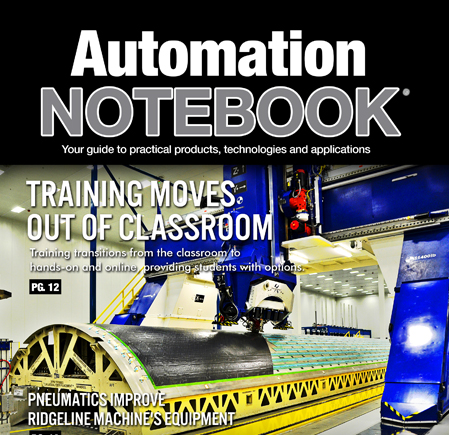This issue of NOTEBOOK is not only filled with information about our latest products but also interesting technical articles. In our Tech Brief article, we help you understand the basics of ladder logic. We also have a great article which explains why pneumatics can be beneficial in motion applications. That’s just a taste of what is inside this issue. Of course, we didn’t forget to include everyone’s favorite — the Break Room is stocked with more fun, and potentially trying, brainteasers.
– TJ Johns Senior Editor
In this issue of the Automation Notebook…
The latest CLICK PLCs are three to ten times faster than existing CLICK PLC units. Ethernet Basic PLC units and Ethernet Standard PLC feature one built-in 10/100 Mbps Ethernet communications port for both programming and Modbus TCP networking, plus one standard RS-232 serial communications port; Ethernet Standard PLC units add an RS-485 port.
+Tech TopicsAutomation NotebookeBookIssue 34 - 2016Learning ResourcesNotebook IssuePneumatic eBookPneumatics eBook
Why Use Pneumatics?
In manufacturing facilities, compressed air is so widely used that it is often regarded as the fourth utility after electricity, natural gas and water. But compared to electricity, compressed air is more expensive, so why is it so widely used to drive factory automation systems?
Teachers often cover subject matter at the speed of the least experienced student, which is helpful for them, but is less productive for more advanced trainees. Classroom training in general can be quite tedious, and also very expensive compared to more modern alternatives.
Readers of Automation Notebook have their favorite section. For most, that section is The Break Room. This is often the first place many readers go to once they receive the latest issue.
Each issue of the Automation Notebook features a section we call, “The Break Room”. Now that you’ve successfully solved each puzzle, and before you brag to your coworkers, you can double check the brainteaser answers from Issue 34, 2016 of Automation Notebook below. If you want to return to the brainteasers questions, click here. 1.) Mirror, mirror,…
ApplicationApplication StoriesAutomation NotebookeBookIndustryIssue 34 - 2016Learning ResourcesManufacturingMaterial HandlingNotebook IssueOnline OnlyPackagingPLCPneumaticsProductProgrammable ControlSimple PLCUser Solutions
CLICK PLCs and Pneumatics Team Up for Success at Ridgeline Machine
Ridgeline Machine made extensive use of pneumatics when building a low-cost, small-footprint, portable traymaker to replace a manual process for one of their customers. Ridgeline Machine Design, LLC (RMD), founded in 2012, is primarily a packaging machinery producer, and the company’s owners have over 40 years experience designing and building custom machinery. RMD builds packaging…
ApplicationApplication StoriesAutomation NotebookAutomationDirect SpotlightData System MonitoringEducation/DIYIndustryIssue 34 - 2016Learning ResourcesMotion ControlNotebook IssueOnline OnlyOperator InterfacePLCPLC eBookProductProgrammable ControlStudent SpotlightStudent SpotlightWater/Wastewater
Portable Water Treatment Platform Removes Phosphorus Economically
A trailer-mounted water treatment process controlled by a Productivity2000 PLC has recently been developed at the University of Idaho. Professor Greg Möller, in the College of Agriculture and Life Sciences, along with engineers from the College of Engineering have teamed up to build the platform, and to further research the economical removal of phosphorus from various…
+Tech TopicsAutomation NotebookeBookIssue 34 - 2016Learning ResourcesNotebook IssueOnline OnlyPLC eBookProductProgrammable ControlTechnology Brief
What is Ladder Logic?
PLCs have exploded in the controls market and are used throughout the world. Over time they have advanced to become more user friendly, efficient, smaller and less expensive. Different types of programming languages have also been developed for PLCs but the most frequently used is still Ladder Logic. The Origins of Ladder Logic – Relay…



